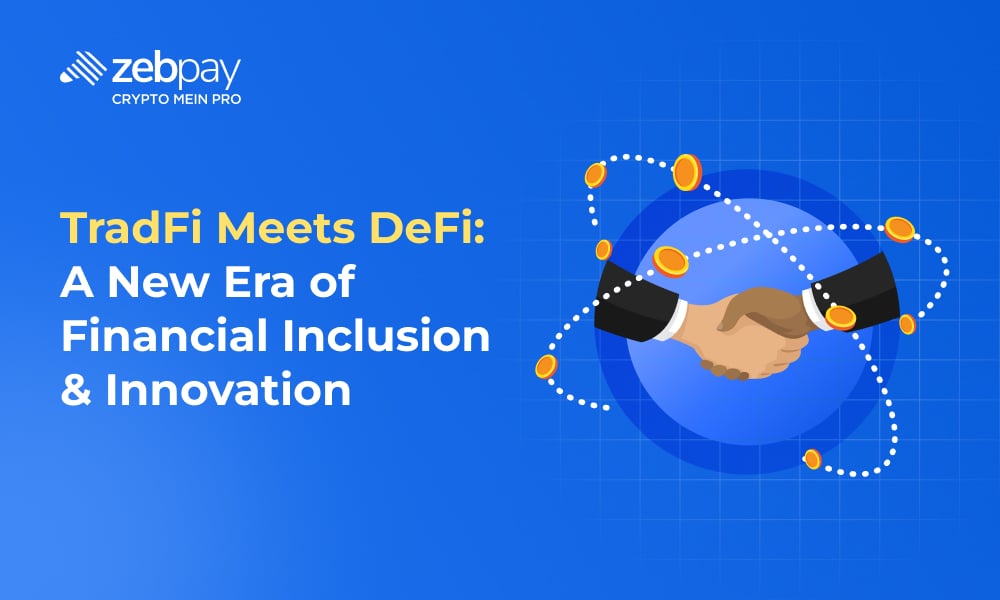We are, currently, witnessing a merger in the financial space between traditional finance (TradFi) and decentralised finance (DeFi). This alliance highlights a significant shift in how both the TradFi and DeFi sectors of the financial ecosystem create a strong synergy for growth, innovation, and inclusion of the global financial space. This article explores the powerful synergy of DeFi and TradFi.
TradFi: What does it mean?
TradFi refers to the ‘old-fashioned’, decades-old financial system that involves customer funds being managed by centralised intermediaries such as banks, insurance companies, stock markets, or other regulated, licensed, and authorised financial intermediaries.
Used in this context, which refers to these orthodox, centralised systems of finance, as opposed to more DeFi commercial activities and platforms that use blockchain technology and don’t require centralised intermediaries to effectuate transactions. Under TradFi, banks and other centralised financial intermediaries make and facilitate business dealings, often for a fee.
However, since consumers of traditional finance (TradFi) systems don’t maintain any legal titles to these assets, they necessarily rely on the goodwill of the financial institutions that hold them. TradFi systems are also highly regulated and require licences for the businesses involved. Financial authorities oversee these systems, and, most importantly, TradFi transactions are reversible under specified conditions—they are not immutable.
DeFi: What does it mean?
The term DeFi refers to these new financial technologies that are built upon distributed ledgers, such as those used by crypto. DeFi cuts out the middleman (exchanges, banks, and corporations) and utilises a distributed, decentralised model that operates without a top-down management system. This system places much more power and control within individuals’ ownership of assets.
It eliminates banking and financial service fees, while the user securely stores funds in cold digital wallets, instantaneously transfers them, and has access to open finance. It is intended to provide users with a completely decentralised solution to the centralised finance and fiat currency systems of the past.
Read more: DeFi
The evolution of DeFi and TradFi
TradFi consists of incumbent, highly-controlled financial systems, including banks, investment firms, and insurance companies. While these institutions offer stability and safety, TradFi also leads to a lack of inclusivity and inefficiency; groups already facing the challenges of being unbanked or underbanked can be particularly affected.
On the blockchain-inspired DeFi is a democratic disruptor, built on a decentralised network, hosting open-access protocols and smart contracts designed to foster greater financial inclusiveness and potentially higher yields. But it in turn faces regulatory uncertainty and security issues.
Why Collaboration is Necessary
Rather than seeing TradFi and DeFi as adversaries, they need to see potential and a synergistic relationship, as TradFi and decentralised technologies have enormous potential for working together. DeFi can automate, optimise, and increase transparency within TradFi, and could help create an expanded and more efficient financial system; financial inclusion may increase as costs decrease and lending processes speed up.
As more traditional institutions embrace blockchain technology and adopt decentralised ways of doing business, we will see innovative new hybrid models leveraging the benefits of both the worlds of TradFi and DeFi, and bridging high-trust traditional institutions with open access and transparency.
Achieving this synergy will require collaboration and partnerships between the traditional gatekeepers of finance and the nascent blockchain initiatives, and it involves a rethinking of the traditional fiat and regulatory frameworks upon which the financial infrastructure is based. By introducing the best of blockchain into the existing ecosystem, the traditional financial plumbing can be reassessed for optimal financial services, yet within an auditable and regulatory framework.
Read more: TradeFi meets DeFi
Use cases for collaboration
Let’s explore a few examples of collaboration between DeFi and TradFi:
- A decentralised lending platform, called MakerDAO, enables borrowers to access loans by offering crypto as collateral and allows users to mint Dai, a stablecoin pegged to the US dollar.
- Another one, Circle, is a peer-to-peer payments technology company promising to ‘bring DeFi and TradFi Together’ via blockchain. Using USDC, Circle allows users to send money internationally, using new technology that combines the advantages of TradFi and DeFi with a single click.
Benefits and Challenges
Here are some of the key benefits and challenges of a DeFi and TradFi collaboration:
Benefits:
- Increased efficiency and transparency:
DeFi uses smart contracts, which can automate financial processes like payments, settlements, and loan agreements without intermediaries, reducing time and costs. Traditional financial institutions can adapt to this to streamline operations. Blockchain-based systems are transparent by nature, offering full visibility into transaction histories and fund movements. This can improve trust in TradFi systems.
- Access to new markets:
DeFi is decentralised, global, and offers 24/7 access to a host of services—two factors that could allow TradFi institutions the ability and opportunity to reach populations that have been historically underserved or even entirely unbanked, since it lowers the barrier to entry for many core financial services.
- Financial Inclusion
For instance, DeFi has the potential to cut out intermediaries, making transactions less expensive and services more affordable (especially for consumers in regions where the banking infrastructure is underdeveloped). TradFi could use DeFi to reach consumers currently excluded from the financial system.
Challenges:
- Regulatory Uncertainty:
This possibly holds DeFi back by making it too vague for TradFi institutions to onboard fully, whereas they might be inclined if compliance risks were explicitly tackled.
- Security and Fraud Risks:
DeFi smart contracts, if not audited, often leave bugs and vulnerabilities that lead to hacks. TradFi entities might still have qualms about the extensive exposure to such risks.
- Technology Integration and Legacy Systems
TradFi relies on legacy systems, and integrating with blockchain technology can be complex and costly. DeFi operates on decentralised protocols that may not be compatible with the centralised TradFi infrastructure.
Future Outlook: A Hybrid Model
Combining the robustness of TradFi with the inclusiveness of DeFi can bring about a more comprehensive financial landscape that addresses the needs of a diversified population. TradFi can offer the security assurances and regulatory framework, which DeFi currently lacks. DeFi can provide a democratic financial system that provides far more diverse and inclusive funding options than are currently accessible in the traditional financial system.
Yet the shift towards a hybrid financial system is not going without a hitch. Regulation remains a primary obstacle, with governments around the world still grappling with the task of overseeing the emerging patchwork of finance. Balancing compliance with the decentralisation inherent in DeFi presents a significant challenge. Additionally, security remains a critical consideration as integration progresses. Developers and financial institutions must enhance security measures to protect investors and sustain trust in the system.
Conclusion
The existence of TradFi provides a backbone to the financial system, including much-needed stability, confidence, and regulatory compliance. DeFi has massive promise for open access and innovation, but, together, TradFi and DeFi can work to create a more inclusive, efficient, and resilient financial system.
Another major advantage of the TradFi and DeFi merger is greater financial inclusion. The DeFi’s decentralised quality can provide services to individuals, directly, and bypass intermediaries such as banks. In this way, more people can have more access to the financial sectors, especially in non-developed regions where the banking services are not available or simply less accessible.
By drawing on the strengths of the networks inherent in our established financial system, we can fully realise the potential of emerging decentralised technologies in a way that preserves the integrity of existing financial rails and brings the protections we expect. Together, let’s work to build a financial ecosystem that embodies the best of both worlds to help individuals and businesses thrive in the future.
Unravel everything that you need for your crypto journey via ZebPay blogs. Get started today and join 6 million+ registered users on ZebPay!







